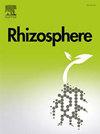增加氮添加量可减少药用淫羊藿根际分泌物,抑制其根际微生物活性
IF 3.4
3区 生物学
Q1 PLANT SCIENCES
引用次数: 0
摘要
全球变化影响药用植物健康和生态系统功能,因此了解环境变化对药用植物地上生物量和地下根系分泌物的影响至关重要。以淫羊藿(Epimedium pubescens Maxim)为研究对象。这是一种原产于中国四川的草药,旨在研究氮沉降的影响。施氮量分别为0(对照)、25(低氮)、50(高氮)kg N ha - 1 yr - 1,测定生物量并分析根系分泌物通量。研究还评估了根际和非根际土壤的微生物生物量,以及土壤C和N的矿化率,揭示了根渗出物C输入的季节性动态。关键结果表明:(1)生物量分配变化显著,低氮和高氮处理下叶片生物量比对照增加45.52%和32.61%,而高氮处理下根系生物量比对照减少24.24% (P <;0.05)。(2)氮肥处理下,根系分泌物C输入量分别比对照减少17.54%(单位质量)、22.85%(单位长度)和28.18%(单位面积),其中高氮抑制效果最强。(3)根际对碳矿化的影响从137.70±2.00 %(对照)降低到92.4±1.3%(高氮),微生物生物量C(109.34%→82.48%)和N(120.03%→90.69%)也相应降低(P <;0.05)。季节分析显示,根际活性在夏季最大,氮抑制在5 - 8月最强(减少49.09%)。氮添加量的增加减少了根源碳输入,抑制了根际微生物活动,同时改变了毛菖蒲生物量的分配模式。结果表明,在药用植物栽培中,最佳氮素管理必须平衡生产力和土壤健康。本文章由计算机程序翻译,如有差异,请以英文原文为准。
Increasing nitrogen addition reduces root exudates and suppresses microbial activity in the rhizosphere of medicinal Epimedium pubescens
Global change impacts medicinal plant health and ecosystem functions, making it essential to understand how environmental changes affect aboveground biomass and belowground root exudates in medicinal plants. This study focused on Epimedium pubescens Maxim., a medicinal herb native to Sichuan, China, to examine the effects of nitrogen deposition. Various nitrogen (N) addition treatments 0 (control), 25 (low-N), 50 (high-N) kg N ha−1 yr−1 were applied to measure biomass and analyze root exudate flux. The study also assessed microbial biomass in rhizosphere and non-rhizosphere soils, as well as soil C and N mineralization rates, revealing seasonal dynamics of root exudate C input. Key results show: (1) Biomass allocation shifted significantly, with leaf biomass increasing by 45.52 % under low-N and 32.61 % under high-N versus control, while root biomass decreased by 24.24 % under high-N versus control (P < 0.05). (2) Root exudate C input declined by 17.54 % (unit mass), 22.85 % (unit length), and 28.18 % (unit area) under N addition relate to control, with strongest suppression at high-N. (3) Rhizosphere effects on C mineralization decreased from 137.70 ± 2.00 % (control) to 92.4 ± 1.3 % (high-N), with parallel reductions in microbial biomass C (109.34 %→82.48 %) and N (120.03 %→90.69 %) (P < 0.05). Seasonal analyses revealed maximal rhizosphere activity in summer and strongest N inhibition in May–August (49.09 % reduction). Increasing nitrogen addition reduces root-derived carbon inputs and suppresses rhizosphere microbial activity, while altering biomass allocation patterns in E. pubescens. The results suggest optimal N management must balance productivity and soil health in medicinal plant cultivation.
求助全文
通过发布文献求助,成功后即可免费获取论文全文。
去求助
来源期刊

Rhizosphere
Agricultural and Biological Sciences-Agronomy and Crop Science
CiteScore
5.70
自引率
8.10%
发文量
155
审稿时长
29 days
期刊介绍:
Rhizosphere aims to advance the frontier of our understanding of plant-soil interactions. Rhizosphere is a multidisciplinary journal that publishes research on the interactions between plant roots, soil organisms, nutrients, and water. Except carbon fixation by photosynthesis, plants obtain all other elements primarily from soil through roots.
We are beginning to understand how communications at the rhizosphere, with soil organisms and other plant species, affect root exudates and nutrient uptake. This rapidly evolving subject utilizes molecular biology and genomic tools, food web or community structure manipulations, high performance liquid chromatography, isotopic analysis, diverse spectroscopic analytics, tomography and other microscopy, complex statistical and modeling tools.
 求助内容:
求助内容: 应助结果提醒方式:
应助结果提醒方式:


